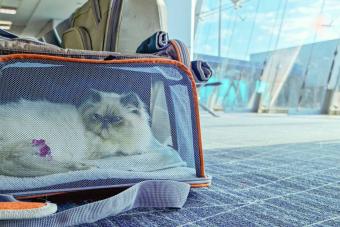
Taking your cat with you on a trip is a lot different from traveling with your dog. Most dogs are used to going out in public, while few cats are leash-trained. Plus, you have to bring a litterbox, and not to mention, cats aren't known for being the calmest travel companions. It is possible to travel with your cat, however, especially if you bring the right stuff and take the proper precautions. Whether you're traveling by car or plane, with the right preparation, it can be a smooth and stress-free experience for both of you.
Pack Your Cat's Road Trip Bag
Before you leave, pack a kitty to-go bag. Here are the items you should include when you're packing:
- Food and Water: Pack enough of your cat's regular food for the duration of the trip, plus a bit extra in case of delays. Also, remember to bring a portable water dish and a supply of fresh water.
- Litter and Litter Box: Bring a portable or disposable litter box and enough litter for your trip.
- Trash bags: If you're transporting your cat by car, be sure you have trash bags on hand to dispose of litter on the way. There are few things worse than being stuck in a car with a soiled litterbox.
- Leash and Harness: Even if your cat isn't accustomed to using a leash and harness, it's important to have one for safety during pit stops.
- Comfort Items: Include favorite toys, a blanket, or a piece of your clothing. Familiar smells can help comfort and soothe your cat.
- Cleaning Supplies: Pack some disposable gloves, plastic bags, paper towels, and pet-safe disinfectant for any messes or accidents, especially if you're traveling by car.
- First Aid Kit: Include basic items such as bandages, gauze, tweezers, a digital thermometer, and any medication your cat may need. Also, keep the phone number of your vet and a national vet hotline.
- Medication: If your cat requires any medication, be sure to bring an adequate supply. This includes any travel-related medication your vet may have recommended, like anti-anxiety aids or full-spectrum hemp extract.
- Health Records: In case of an emergency, it's useful to have a copy of your cat's vaccination records and other health information - and this information may even be required if you're traveling internationally.
- Treats: Pack your cat's favorite treats to make the journey a bit more enjoyable for them.
- Bed or Cushion: If there's enough space, consider bringing your cat's bed or a familiar cushion or blanket to make them more comfortable during the journey.
Remember, each trip and cat will be different, so this list might need to be adjusted based on your cat's needs and whether you're traveling by car, plane, bus, or train.
Get a Good Cat Carrier
Selecting a cat carrier for travelling requires thoughtful consideration to ensure your feline friend's comfort and safety. When you're looking at cat carriers to use for travel, it's important to:
- Find the right size: Your cat should be able to stand, turn around, and lie down comfortably, but still be small enough to keep them cozy in a small area.
- Picking the material: Look for a carrier that's sturdy, well-ventilated, and easy to clean.
- Flying by air: If you're flying by airplane, you will need a carrier that's airline-approved.
You should also consider your cat's personality and stress levels. Some cats might prefer a carrier with a top opening, while others may prefer a carrier with darkened sides to feel more hidden and secure. Always ensure the carrier has a soft, comfortable bottom so they can lie down easily.
Traveling By Car
Traveling by car with your cat can be relatively simple with the right prep. Secure your cat's carrier to keep them safe and prevent them from roaming freely inside the car, which could be dangerous. Make sure you familiarize your cat with the carrier ahead of time so they're not piled with stress the first minute of the trip.
If you're planning a long drive, ensure that you take frequent breaks for your cat to stretch, hydrate, and use the litter box. Keep the car temperature comfortable and play calming music to help ease anxiety.

Never leave your cat inside your car if you aren't inside too, as it can become fatally hot very quickly. Just like you wouldn't leave a dog unattended, the same rules apply for your cat.
Using the Litterbox
Using a litter box while on a car ride can be tricky for a cat, and it requires some planning. For short trips, your cat likely won't need to use the litter box. For longer trips, provide a portable, travel-sized litter box during rest stops.
Cats prefer privacy while doing their business, so find a quiet and relatively secluded area for your cat to use the litter box. If your car is spacious, you may be able to set up a litter box in the back of the vehicle, but make sure the car is in park before letting them out of their carrier. Never let your cat loose in the car while it's moving, as it can be a safety hazard for both you and the cat.
Some cats don't feel comfortable enough to use the litter box during travel. There's a chance that accidents may happen. Bringing cleaning supplies and spare litter can help manage any mishaps.
Traveling By Air
Traveling by airplane with your cat requires careful planning. Here are some steps to help:

- Step 1: Check the airline's pet policy. Rules can vary widely, with some airlines allowing small pets in the cabin and others requiring them to travel in the cargo hold.
- Step 2: Consider a direct flight to avoid the stress of layovers and make the journey as short as possible.
- Step 3: Make sure you have an airline-approved pet carrier with adequate ventilation and comfort. Familiarize your cat with the carrier several weeks before your trip to reduce anxiety.
- Step 4: Feed your cat several hours before the flight to minimize the chances of upset stomach.
- Step 5: Consider asking your vet for a sedative to keep your cat calm.
If your cat will be in cargo, label the carrier with "Live Animal," your contact information, and a note about any special needs your cat has.
Get Your Cat a Pre-Travel Checkup
Before beginning your road trip, schedule a visit to the veterinarian to ensure your cat is in good health. Not only will the vet check your cat's overall health, they will also update vaccinations, and give you time to discuss any concerns about traveling with your cat. If your cat gets anxious or motion sick, your vet may have advice or provide a prescription to help them get through it.

Check the Accommodations
Before traveling with your pet, make sure your accommodations are pet-friendly and suitable for your pet's needs. Start by confirming with the hotel or rental property that they allow pets and ask about any additional fees or restrictions that may apply. Ask detailed questions about the facilities available for pets, such as designated pet relief areas, availability of pet food and supplies, and nearby veterinary services.
It's also important to learn the rules about leaving pets unattended in the room. If you're staying with friends or family, make sure they are comfortable with your pet being in their home and that the environment is safe. This includes checking for potential hazards like toxic plants or substances, accessible trash bins, or escape routes. Also consider your pet's behavior and needs; an anxious pet or one with special needs will be more difficult to care for.
Make This a Positive Experience
Traveling with a cat requires careful preparation, but with these steps, it can be a positive experience for both of you. Remember that each cat is unique, and what works for one might not work for another. So, tune into your cat's needs, ensure their comfort and safety, and enjoy your travels together.







